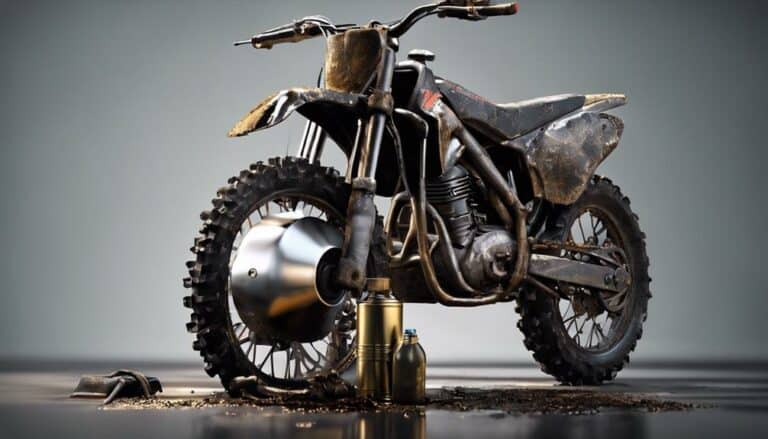If you've noticed a change in your dirt bike's engine sound, like a sudden increase in noise levels, it might be a sign that an oil change is due.
However, engine noise is just one of the key indicators that it's time to contemplate renewing your bike's oil.
By paying attention to these subtle signs, you can prevent potential damage and keep your dirt bike running smoothly.
Key Takeaways
- Darkening oil indicates contaminants affecting lubrication.
- Low oil levels lead to increased friction and engine damage.
- Excessive engine noise signals degraded oil and the need for a change.
- Performance degradation like reduced power output indicates the necessity of an oil change.
Oil Color Changes
When monitoring the oil color in your dirt bike, the darkening from brown to black indicates the presence of contaminants, signaling the need for an oil change. Fresh engine oil appears in shades of red, yellow, or orange, while as it ages, the color shifts to a darker and denser hue, reflecting the accumulation of impurities like dirt, dust, and carbon deposits.
Regularly checking the oil color is vital to gauge the level of contaminants affecting proper engine lubrication. By monitoring oil color changes every month, you can make sure that your engine parts receive the lubrication they need to function at their best. Contaminants in the oil not only darken its color but can also lead to increased friction between engine components, potentially causing damage.
Maintaining a watchful eye on the oil color in your dirt bike is a proactive way to safeguard your engine's health and performance.
Low Oil Levels
Monitoring the oil levels in your dirt bike is essential to prevent engine damage and guarantee proper lubrication. Low oil levels pose a serious threat to your motorcycle's engine. Without an adequate amount of oil, the engine lacks the necessary lubrication to function correctly. This can lead to increased friction, overheating, and potential seizing of the engine components. It's vital to regularly check and maintain the oil levels in your dirt bike to avoid these issues.
If the oil levels in your dirt bike are consistently low, it can result in poor engine performance, abnormal engine noises, and ultimately, engine damage. Running the engine with low oil levels can lead to costly repairs and potentially shorten the lifespan of your motorcycle. To prevent these complications, make sure to monitor your oil levels regularly and top up as needed. Proper oil maintenance is key to ensuring your dirt bike's engine operates smoothly and efficiently.
Loud Engine Noise
To identify signs of an oil change need in your dirt bike, pay close attention to any excessive engine noise that may indicate degraded oil lubrication. Loud engine noise, especially metal-on-metal sounds, can be a clear indicator that your dirt bike requires an oil change. Here are some points to contemplate:
- Unbearable engine noise and metal-on-metal sounds are clear indicators that it's time for an oil change in a dirt bike.
- Familiarizing yourself with your bike's normal engine sounds can help you identify any unusual loudness that signals the need for an oil change.
- Loud engine noise can be a result of degraded oil that's no longer effectively lubricating engine parts.
- Regularly monitoring engine noise can help you catch any changes that might indicate the need for an oil change in your dirt bike.
- Addressing loud engine noise promptly by changing the oil can prevent potential damage and maintain peak performance of your dirt bike.
Declining Performance
If you notice your dirt bike experiencing a decline in performance, such as reduced power output or sluggish throttle response, it may be time to contemplate an oil change. Dirty oil can lead to issues like sluggish response time when you twist the throttle, affecting your engine performance. Starting issues and a rough idle could also be symptoms of the need for an oil change.
Poor acceleration and hesitations during gear shifts are indicators that your engine mightn't be receiving the lubrication it needs. Additionally, misfires or stalling at low speeds could be a result of old or insufficient oil in your dirt bike. Ensuring your oil is clean and at the correct level is essential to maintaining top-notch engine performance. If you're experiencing any of these problems, it's advisable to ponder changing your oil to keep your dirt bike running smoothly and efficiently.
Engine Overheating
Engine overheating signals the urgent need for an oil change in your dirt bike. If your engine is overheating, it could be due to a lack of engine oil, leading to increased friction and heat buildup within the engine components. This lack of lubrication can result in engine seizure, causing irreversible damage to your dirt bike's engine.
To prevent such issues, it's important to monitor your engine temperature regularly. By ensuring that you have a sufficient amount of clean oil in your dirt bike, you can maintain the best engine temperature and reduce the risk of overheating. Remember, regular oil changes are essential to keep your dirt bike running smoothly and prevent overheating problems that can compromise your ride.
- Lack of engine oil causing increased friction and heat buildup
- Risk of engine seizure and irreversible damage
- Importance of monitoring engine temperature
- Regular oil changes for maintaining best engine temperature
- Prevention of overheating issues through proper lubrication
Conclusion
To sum up, when the oil in your dirt bike turns as dark as a moonless night, the engine whispers of low levels, and performance falters like a wilting flower, it's time for an oil change.
Don't let the engine overheat like a blazing sun in the desert. Keep your dirt bike running smoothly by heeding the signs and maintaining proper oil levels.
Your bike will thank you with a purr of gratitude.

